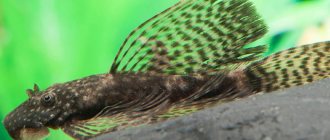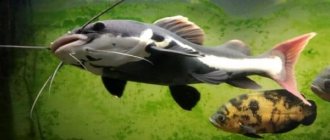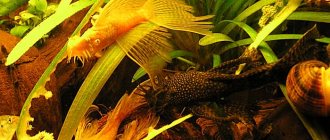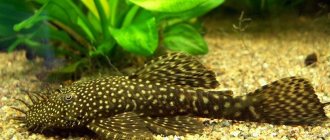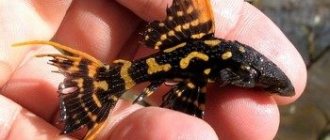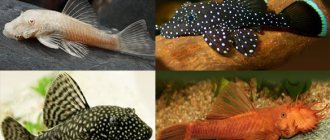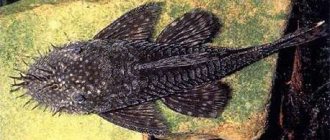Habitat
It comes from South America from the Cuaibá River basin, located mainly in the Brazilian state of Mato Grosso.
Catfish are found mainly in the upper reaches, in rivers and streams with moderate and fast flows of water, with substrates of boulders and snags. Brief information:
- Aquarium volume - from 50 liters.
- Temperature - 23–28°C
- pH value – 6.0–7.5
- Water hardness – 2–15 dGH
- Substrate type - sandy or rocky
- Lighting - dim
- Brackish water - no
- Water movement - moderate to strong
- The size of the fish is up to 7 cm.
- Food - any sinking food
- Temperament - peaceful
- Keeping alone in company with other species
Ancistrus
In South America, in the Amazon River basin (Guyana, Brazil, Peru), in fast-flowing rivers, an interesting representative of the chain catfish is found - the common ancistrus (Ancistrus dolichopterus).
Ancistrus is a popular aquarium fish, interesting not so much for its beauty as for its originality.
Particularly noteworthy is the rounded lower mouth and elongated lips with horn-like suckers, thanks to which the fish hold well in strong currents and can live in fast-flowing waters, clinging to stones and snags. The oral sucker has horny tubercles (sometimes called a “grater”), designed for scraping various plant and animal fouling from the surface of plants, stones and other objects.
The body of the fish is covered with a shell of keratinized plates. Unlike other representatives of chain catfish, aquarium ancistrus grow no more than 15 cm.
In adult catfish, sexual dimorphism is well expressed: females, as a rule, are larger, longer and slimmer than males, their bodies are taller, and their fins are longer and sharper. Males have skin growths (“whiskers”) arranged in pairs on their heads around the upper jaw, which in older individuals reach 1-2 cm and even branch. In females, the processes are poorly developed throughout their lives and are almost invisible.
In aquariums, as a rule, they are kept together with other fish. Ancistrus behave peacefully, but with irregular feeding they become aggressive and carnivorous.
Nowadays, there are several types of Ancistrus, and in addition, their different color variations have been bred.
Quite often in aquariums the albino form of the common ancistrus is found:
Bright yellow albinos are called golden. On dark ground, golden ancistrus looks unusual and bright:
The veil form of ancistrus, characterized by enlarged fins, looks very advantageous:
Other types of ancistrus can also often be found in aquariums, for example the star ancistrus (Ancistrus hoplogenys), which is distinguished by more contrasting white dots on a dark background:
Red ancistrus is found in the reservoirs of Venezuela; recently, breeders have bred a rich red subspecies - Acistrus Super Red:
In the aquariums of Ancistrus lovers you can see the blue Ancistrus:
Ancistrus claro, which lives in the upper reaches of the Paraguay River (South America), has an attractive spotted color and small size (it grows up to 8 cm).
The genus Ancistrus has more than 50 species, so the variety of colors undoubtedly contributes to the popularity of these catfish among aquarists.
To keep ancistrus, it is recommended to use a fairly spacious aquarium, from 100 liters. A large aquarium volume is needed to avoid problems with territoriality of catfish. In general, ancistrus are unpretentious; the main thing is that the water in the aquarium is clean, fresh and actively saturated with oxygen.
Ancistrus adapt to water parameters within a fairly wide range, the main thing is to avoid sudden changes in parameters: water temperature 22-26 ⁰C, pH 6.0-7.5. It is advisable to plant the aquarium with plants. Ancistrus is a very mobile and active fish, so it needs a lot of space in the aquarium. Also, various shelters and grottoes where the catfish could hide and rest would not hurt.
You can feed ancistrus with almost any food for aquarium fish (especially bloodworms or tubifex). It is advisable to add food of plant origin (cucumbers, zucchini, lettuce, cabbage and other vegetables) to the diet. Tough vegetables are sometimes boiled to soften or scalded. You can feed ancistrus with special tablets for catfish, for example, based on spirulina.
Description
Adults reach a length of up to 7 cm. The fish has a flattened body, covered with hard plates, like chain mail (hence the name of the family Chainmail catfish). The surface is rough and dotted with many small spines. The first rays of the fins are significantly thickened and turned into sharp spines. On the head there are several dozen fleshy tentacles designed to search for food. The color is gray with a brown pattern. Sexual dimorphism is weakly expressed. Males and females have no obvious visible differences.
- Fish
- Catfish and Loaches
Showing all 56 results
| Platydoras striped, Singing catfish (Platydoras costatus) In stock | ₽ 110.00 | Add to cart |
| Sturisoma aureus (Sturisoma) In stock | ₽ 320.00 – ₽ 520.00 | Select options |
| Pygmy corridor (Corydoras pygmaeus) In stock | ₽ 140.00 | Add to cart |
| Mystus striped, Mystus cobalt (Mystus tengara) In stock | ₽ 100.00 | Add to cart |
| Ancistrus tiger, Golden leopard (Ancistrus dolichopterus "Gold Leopard") In stock | ₽ 160.00 | Add to cart |
| Corridoras Venezuela "Black" (Corydoras venezuelanus) In stock | ₽ 150.00 | Add to cart |
| Albino catfish (Hoplosternum thoracatum albino) In stock | ₽ 160.00 | Add to cart |
| Gastromizon punctulatus (Gastromyzon punctulatus) In stock | ₽ 210.00 | Add to cart |
| Sevellia punctata (Sewellia SP) In stock | ₽ 300.00 | Add to cart |
| Pangassius highfin (Pangasius sutchii var.) In stock | ₽ 800.00 | Add to cart |
| Sevellia lined (Sewellia lineolata) In stock | ₽ 250.00 | Add to cart |
| Plecostomus albino (Hypostomus plecostomus) In stock | ₽ 300.00 | Select options |
| Venezuela corridor "Orange" (Corydoras venezuelanus) In stock | ₽ 150.00 | Add to cart |
| Pangassius (Pangasius sutchii var.) In stock | ₽ 270.00 | Add to cart |
| Botia marble (Botia lohachata) In stock | ₽ 150.00 | Add to cart |
| Clown botia (Botia macracantha) In stock | ₽ 730.00 | Add to cart |
| Adolf's corridor (Corydoras adolfoi) In stock | ₽ 160.00 | Add to cart |
| Acanthophalmus Kühl (Pangio kuhlii, Acanthophthalmus kuhlii) In stock | ₽ 120.00 | Add to cart |
| Hypancistrus L-236 (Hypancistrus sp. L236) In stock | ₽ 1,920.00 – ₽ 3,040.00 | Select options |
| Catfish Panda (Corydoras panda) In stock | ₽ 140.00 | Add to cart |
| Catfish Golden (Corydoras aeneus) In stock | ₽ 50.00 Special price | Add to cart |
| Speckled catfish (Corydoras paleatus) In stock | ₽ 50.00 Special price | Add to cart |
| Common Ancistrus (Ancistrus dolichopterus) In stock | ₽ 45.00 – ₽ 50.00 | Select options |
| Sturiosoma panama (Sturiosoma) In stock | ₽ 300.00 | Add to cart |
| Catfish tarakatum (Hoplosternum thoracatum) In stock | ₽ 90.00 | Add to cart |
| Plecostomus (Hypostomus plecostomus) In stock | ₽ 300.00 – ₽ 450.00 | Select options |
| Pterygoplicht brocade (Pterygoplichthys gibbiceps) In stock | ₽ 300.00 | Add to cart |
| Brochis green (Brochis splendens) In stock | ₽ 160.00 | Add to cart |
| Synodontis dalmatian (Synodontis sp.) In stock | ₽ 140.00 | Add to cart |
| Synodontis eupterus (Synodontis eupterus) In stock | ₽ 140.00 | Add to cart |
| Catfish Clarias (Clarias batrachus) In stock | ₽ 80.00 | Add to cart |
| Star Ancistrus L-181 (Ancistrus hoplogenys) In stock | ₽ 400.00 | Add to cart |
| Catfish "Peacock eye" (Horabagrus brachysoma) In stock | ₽ 300.00 | Add to cart |
| Otocinclus affinnis (Otocinclus affinis) In stock | ₽ 300.00 | Add to cart |
| Pterygoplicht orange marble (Pterygoplichthys sp) In stock | ₽ 400.00 | Add to cart |
| Acantophthalmus nigricans (Acanthophthalmus oblonga) In stock | ₽ 120.00 | Add to cart |
| Zebra botia, striped botia (Botia superciliaris, Botia striata Rao) To order | ₽ 460.00 | Notify about arrival |
| Sacbranch catfish (Heteropneustes fossilis) To order | ₽ 80.00 | Notify about arrival |
| Glass catfish (Kryptopterus bicirrhis) To order | ₽ 350.00 | Notify about arrival |
| Corridors Sterba (Corydoras sterbai) To order | ₽ 160.00 | Notify about arrival |
| Ancistrus Madre De Dios L-393 (Ancistrus sp.) To order | ₽ 240.00 | Notify about arrival |
| Anchor catfish (Hara Jerdon) (Hara Jerdoni) To order | ₽ 150.00 | Notify about arrival |
| Tiger botia, botia helodes (Syncrossus helodes, Botia helodes) To order | ₽ 450.00 | Notify about arrival |
| Corydoras trilineatus (Corydoras trilineatus) To order | ₽ 160.00 | Notify about arrival |
| Botia bluish (Botia modesta) To order | ₽ 280.00 | Notify about arrival |
| Agamix stellata (Agamyxis albomaculatus) To order | ₽ 120.00 | Notify about arrival |
| Corridoras Melini (Corydoras melini) To order | ₽ 160.00 | Notify about arrival |
| Panak "Red Zebra" L-397 (Panaqolus sp. L397) To order | ₽ 1,300.00 | Notify about arrival |
| Hypancistrus "Inspector" L-201 (Hypancistrus sp. L201) To order | ₽ 540.00 | Notify about arrival |
| Pseudoplatistoma tiger (Pseudoplatystoma fasciatum) To order | ₽ 900.00 | Notify about arrival |
| Pangassius (Pangasius sutchii) To order | ₽ 80.00 | Notify about arrival |
| Albino pangassius (Pangasius sutchii var. albino) To order | ₽ 90.00 | Notify about arrival |
| Ancistrus L-144 “Black-eyed” Veiled (Ancistrus dolichopterus) To order | ₽ 150.00 | Notify about arrival |
| Ancistrus veil (Ancistrus dolichopterus) To order | ₽ 90.00 | Notify about arrival |
| Ancistrus Super Red (Ancistrus dolichopterus "Super Red") To order | ₽ 150.00 | Notify about arrival |
| Spot Ancistrus L-182 (Ancistrus punctatus sp) To order | ₽ 160.00 | Notify about arrival |
Maintenance and care, arrangement of the aquarium
The optimal aquarium size for one catfish starts from 50 liters. In the design, it is recommended to simulate the bed of a mountain river with substrates of sand and stones of variable size, small pebbles and boulders. Additional decorative elements will be driftwood from tree roots and branches, ceramic hollow tubes or pots turned on their sides, and various decorative items. All this is intended to form secluded corners where the fish could hide. The presence of aquatic plants is not necessary. Contents Ancistrus Claro will not cause much difficulty even for a novice aquarist. To avoid problems, it is necessary to regularly clean the aquarium, replace part of the water weekly (30–40% of the volume) with fresh water, and promptly remove organic waste (excrement, leftover food). Along with other equipment, installing a productive filtration system is important. It solves two problems at once: it purifies the water and creates an internal flow.
Breeding/reproduction
Breeding is simple. With the onset of the mating season, the male and female find each other to form a temporary pair. They spawn in one of the shelters, after which the female swims away, and the male remains to protect the clutch. At this time, he may become a not-so-friendly neighbor, driving away anyone he considers potentially dangerous. Since it is very difficult to determine gender, especially for amateurs, breeding is possible only by purchasing a group of 4–5 or more catfish, so that you are sure to get individuals of different sexes.
